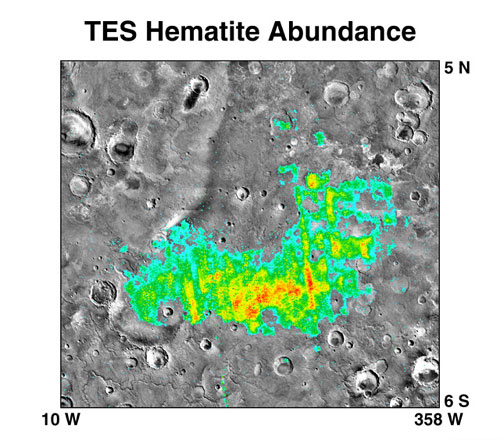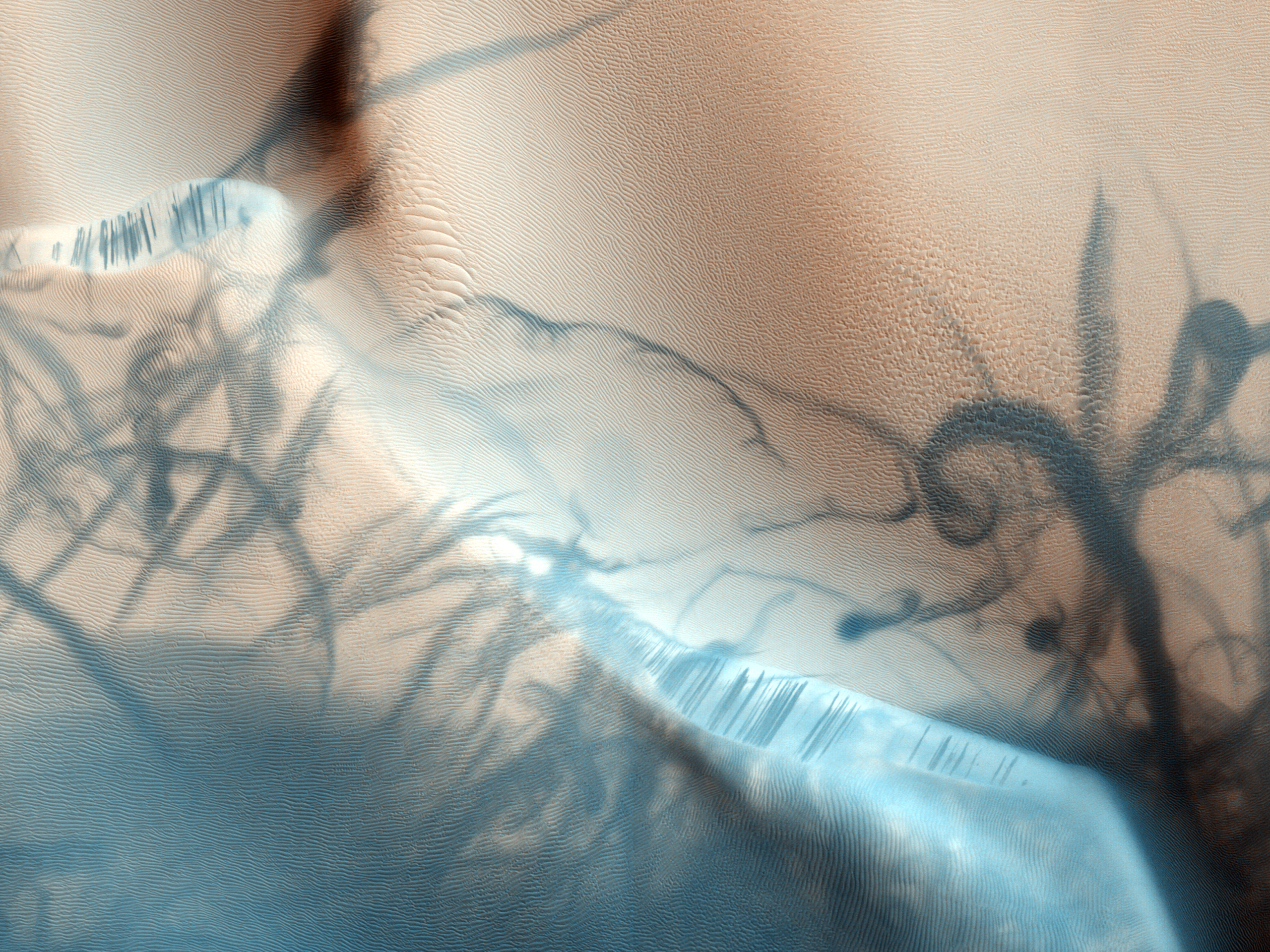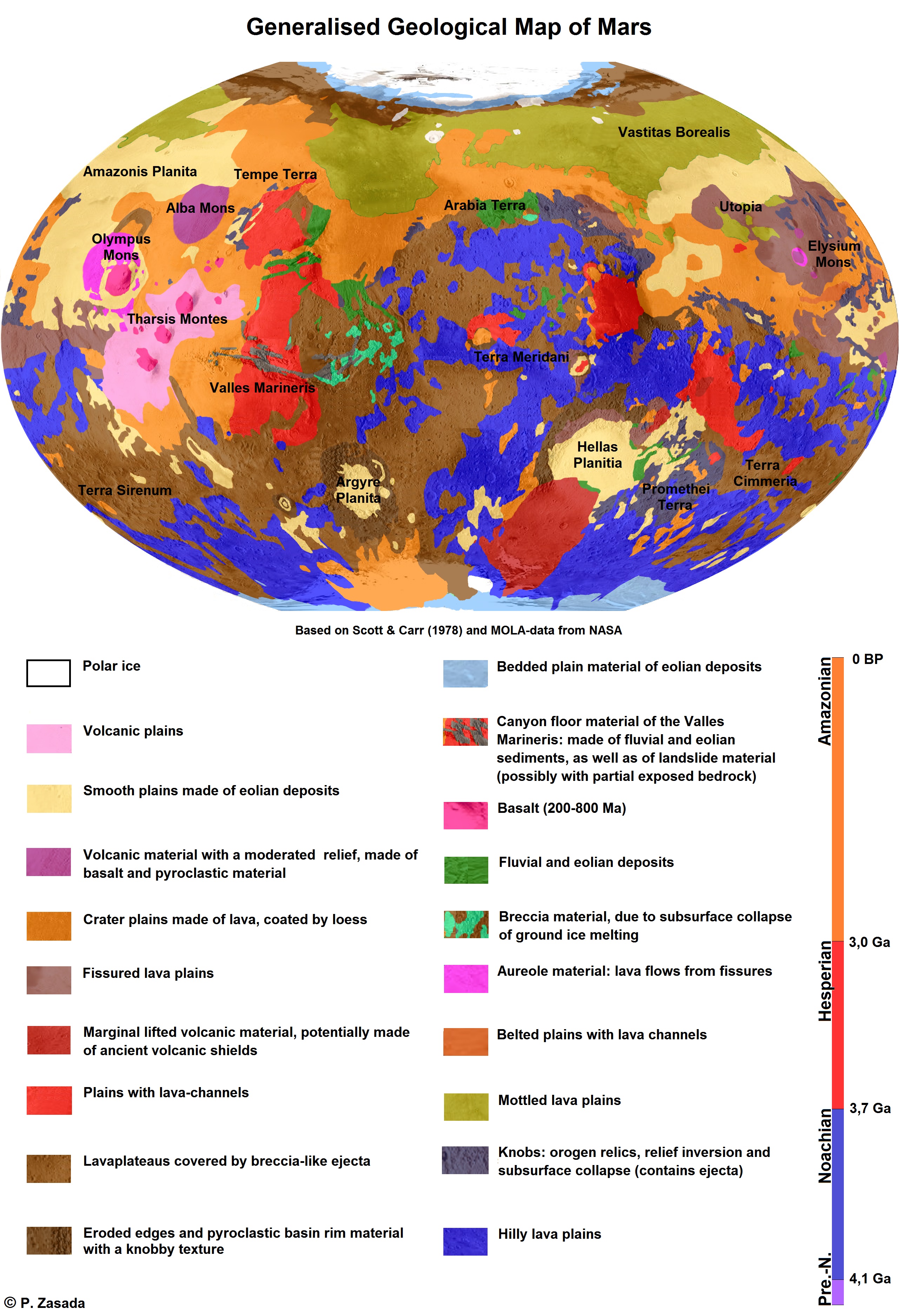|
Nicholson (Martian Crater)
Nicholson is a crater on Mars centered at 0.1° N and 164.5° W. It is wide, and located in the Memnonia quadrangle. Nicholson is a good marker for the equator as it sits almost directly on the martian equator. It is named after Seth Barnes Nicholson, an American astronomer. Nicholson is notable for its central peak, which rises in a high mound 3.5 km above the crater floor. This rounded peak is riddled with channels, which may have been eroded by wind or even water. Wikinicholson.jpg, Western side of Nicholson crater showing part of central mound, as seen by CTX camera (on MRO). Image:Nicholson Crater Mound.JPG, Nicholson crater mound with dark streaks, as seen by HiRISE. See also * Climate of Mars * Dark slope streaks * Geology of Mars * List of craters on Mars * Water on Mars Almost all water on Mars today exists as ice, though it also exists in small quantities as vapor in the atmosphere. What was thought to be low-volume liquid brines in shallow Martian s ... [...More Info...] [...Related Items...] OR: [Wikipedia] [Google] [Baidu] |
Thermal Emission Imaging System
The Thermal Emission Imaging System (THEMIS) is a camera on board the 2001 Mars Odyssey orbiter. It images Mars in the visible and infrared parts of the electromagnetic spectrum in order to determine the thermal properties of the surface and to refine the distribution of minerals on the surface of Mars as determined by the Thermal Emission Spectrometer (TES). Additionally, it helps scientists to understand how the mineralogy of Mars relates to its landforms, and it can be used to search for thermal hotspots in the Martian subsurface. THEMIS is managed from the Mars Space Flight Facility at Arizona State University and was built by the Santa Barbara Remote Sensing division of Raytheon Technologies Corporation, an American multinational conglomerate headquartered in Waltham, Massachusetts. The instrument is named after Themis, the goddess of justice in ancient Greek mythology. Infrared camera THEMIS detects thermal infrared energy emitted by the Martian surface at nin ... [...More Info...] [...Related Items...] OR: [Wikipedia] [Google] [Baidu] |
Mars
Mars is the fourth planet from the Sun and the second-smallest planet in the Solar System, only being larger than Mercury. In the English language, Mars is named for the Roman god of war. Mars is a terrestrial planet with a thin atmosphere (less than 1% that of Earth's), and has a crust primarily composed of elements similar to Earth's crust, as well as a core made of iron and nickel. Mars has surface features such as impact craters, valleys, dunes and polar ice caps. It has two small and irregularly shaped moons, Phobos and Deimos. Some of the most notable surface features on Mars include Olympus Mons, the largest volcano and highest known mountain in the Solar System and Valles Marineris, one of the largest canyons in the Solar System. The Borealis basin in the Northern Hemisphere covers approximately 40% of the planet and may be a large impact feature. Days and seasons on Mars are comparable to those of Earth, as the planets have a similar rotation period a ... [...More Info...] [...Related Items...] OR: [Wikipedia] [Google] [Baidu] |
Seth Barnes Nicholson
Seth Barnes Nicholson (November 12, 1891 – July 2, 1963) was an American astronomer. He worked at the Lick observatory in California, and is known for discovering several moons of Jupiter in the 20th century. Nicholson was born in Springfield, Illinois, and was raised in rural Illinois. He was educated at Drake University, where he became interested in astronomy. In 1914, at the University of California's Lick Observatory, while observing the recently discovered Jupiter natural satellite, moon Pasiphaë (moon), Pasiphaë, he discovered a new one, Sinope (moon), Sinope, whose orbit he computed for his Ph.D. thesis in 1915. He spent his entire career at Mount Wilson Observatory, where he discovered three more Jovian moons: Lysithea (moon), Lysithea and Carme (moon), Carme in 1938, and Ananke (moon), Ananke in 1951. While at the Palomar Observatory in 1957, he discovered 1647 Menelaus, an asteroid near Jupiter. Other work included computing the orbits of several comets and als ... [...More Info...] [...Related Items...] OR: [Wikipedia] [Google] [Baidu] |
Memnonia Quadrangle
The Memnonia quadrangle is one of a series of 30 quadrangle maps of Mars used by the United States Geological Survey (USGS) Astrogeology Research Program. The Memnonia quadrangle is also referred to as MC-16 (Mars Chart-16). The quadrangle is a region of Mars that covers latitude -30° to 0° and longitude 135° to 180°. The western part of Memnonia is a highly cratered highland region that exhibits a large range of crater degradation. Memnonia includes these topographical regions of Mars: * Arcadia Planitia * Amazonis Planitia * Lucus Planum * Terra Sirenum * Daedalia Planum * Terra Cimmeria Recently, evidence of water was found in the area. Layered sedimentary rocks were found in the wall and floor of Columbus Crater. These rocks could have been deposited by water or by wind. Hydrated minerals were found in some of the layers, so water may have been involved. Many ancient river valleys including Mangala Vallis, have been found in the Memnonia quadrangle. Manga ... [...More Info...] [...Related Items...] OR: [Wikipedia] [Google] [Baidu] |
Nicholson Crater On Mars - Topography Map
Nicholson may refer to: People *Nicholson (name), a surname, and a list of people with the name Places Australia * Nicholson, Victoria * Nicholson, Queensland * Nicholson County, New South Wales * Nicholson River (other) * Nicholson Road, Perth * Nicholson Street, Melbourne Hong Kong * Mount Nicholson, Hong Kong Island New Zealand * Port Nicholson, former name of Wellington Harbour, New Zealand United States * Nicholson, Georgia * Nicholson Island (Pennsylvania) * Nicholson, Mississippi * Nicholson, Pennsylvania * Nicholson, Wisconsin * Nicholson Township, Fayette County, Pennsylvania * Nicholson Township, Wyoming County, Pennsylvania * Dr. Malcolm Nicholson Farmhouse, a historic farmhouse in Havana, Florida Craters *Nicholson crater, in Canada *Nicholson (lunar crater) *Nicholson (Martian crater) Other uses * Crest Nicholson, British housebuilding company * ''Fanny Nicholson'', Australian sailing ship that sank in 1874 * Nicholson's, a brewery in Maidenhead from 1 ... [...More Info...] [...Related Items...] OR: [Wikipedia] [Google] [Baidu] |
Mars Reconnaissance Orbiter
''Mars Reconnaissance Orbiter'' (MRO) is a spacecraft designed to study the geology and climate of Mars, provide reconnaissance of future landing sites, and relay data from surface missions back to Earth. It was launched on August 12, 2005, and reached Mars on March 10, 2006. In November 2006, after five months of aerobraking, it entered its final science orbit and began its primary science phase. The cost to develop and operate MRO through the end of its prime mission in 2010 was . The spacecraft continues to operate at Mars, far beyond its intended design life. Due to its critical role as a high-speed data-relay for ground missions, NASA intends to continue the mission as long as possible, at least through the late 2020s. Pre-launch After the twin failures of the '' Mars Climate Orbiter'' and the Mars Polar Lander missions in 1999, NASA reorganized and replanned its Mars Exploration Program. In October 2000, NASA announced its reformulated Mars plans, which reduced the ... [...More Info...] [...Related Items...] OR: [Wikipedia] [Google] [Baidu] |
HiRISE
High Resolution Imaging Science Experiment is a camera on board the ''Mars Reconnaissance Orbiter'' which has been orbiting and studying Mars since 2006. The 65 kg (143 lb), US$40 million instrument was built under the direction of the University of Arizona's Lunar and Planetary Laboratory by Ball Aerospace & Technologies Corp. It consists of a 0.5m (19.7 in) aperture reflecting telescope, the largest so far of any deep space mission, which allows it to take pictures of Mars with resolutions of 0.3m/pixel (1ft/pixel), resolving objects below a meter across. HiRISE has imaged Mars exploration rovers on the surface, including the ''Opportunity'' rover and the ongoing ''Curiosity'' mission. History In the late 1980s, of Ball Aerospace & Technologies began planning the kind of high-resolution imaging needed to support sample return and surface exploration of Mars. In early 2001 he teamed up with Alfred McEwen of the University of Arizona to propose such ... [...More Info...] [...Related Items...] OR: [Wikipedia] [Google] [Baidu] |
Climate Of Mars
The climate of Mars has been a topic of scientific curiosity for centuries, in part because it is the only terrestrial planet whose surface can be directly observed in detail from the Earth with help from a telescope. Although Mars is smaller than the Earth, 11% of Earth's mass, and 50% farther from the Sun than the Earth, its climate has important similarities, such as the presence of polar ice caps, seasonal changes and observable weather patterns. It has attracted sustained study from planetologists and climatologists. While Mars' climate has similarities to Earth's, including periodic ice ages, there are also important differences, such as much lower thermal inertia. Mars' atmosphere has a scale height of approximately , 60% greater than that on Earth. The climate is of considerable relevance to the question of whether life is or ever has been present on the planet. The climate briefly received more interest in the news due to NASA measurements indicating increased sublim ... [...More Info...] [...Related Items...] OR: [Wikipedia] [Google] [Baidu] |
Dark Slope Streaks
Dark slope streaks are narrow, avalanche-like features common on dust-covered slopes in the equatorial regions of Mars.Chuang, F.C.; Beyer, R.A.; Bridges, N.T. (2010). Modification of Martian Slope Streaks by Eolian Processes. ''Icarus,'' 205 154–164. They form in relatively steep terrain, such as along escarpments and crater walls.Schorghofer, N.; Aharonson, O.; Khatiwala, S. (2002). Slope Streaks on Mars: Correlations with Surface Properties and the Potential Role of Water. ''Geophys. Res. Lett.,'' 29(23), 2126, . Although first recognized in Viking Orbiter images from the late 1970s,Morris, E.C. (1982). Aureole Deposits of the Martian Volcano Olympus Mons. ''J. Geophys. Res.,'' 87(B2), 1164–1178.Ferguson, H.M.; Lucchitta, B.K. (1984). Dark Streaks on Talus Slopes, Mars in ''Reports of the Planetary Geology Program 1983, NASA Tech. Memo., TM-86246,'' pp. 188–190. https://ntrs.nasa.gov/archive/nasa/casi.ntrs.nasa.gov/19840015363_1984015363.pdf. dark slope streaks were not ... [...More Info...] [...Related Items...] OR: [Wikipedia] [Google] [Baidu] |
Geology Of Mars
The geology of Mars is the scientific study of the surface, crust, and interior of the planet Mars. It emphasizes the composition, structure, history, and physical processes that shape the planet. It is analogous to the field of terrestrial geology. In planetary science, the term ''geology'' is used in its broadest sense to mean the study of the solid parts of planets and moons. The term incorporates aspects of geophysics, geochemistry, mineralogy, geodesy, and cartography. A neologism, areology, from the Greek word ''Arēs'' (Mars), sometimes appears as a synonym for Mars's geology in the popular media and works of science fiction (e.g. Kim Stanley Robinson, Kim Stanley Robinson's Mars trilogy). The term areology is also used by the Areological Society. Geological map of Mars (2014) File:Geologic Map of Mars figure2.pdf, Figure 2 for the geologic map of Mars Global Martian topography and large-scale features Composition of Mars Mars is a terrestrial planet, which ... [...More Info...] [...Related Items...] OR: [Wikipedia] [Google] [Baidu] |
List Of Craters On Mars
__NOTOC__ This is a list of craters on Mars. Impact craters on Mars larger than exist by the hundreds of thousands, but only about one thousand of them have names. Names are assigned by the International Astronomical Union after petitioning by relevant scientists, and in general, only craters that have a significant research interest are given names. Martian craters are named after famous scientists and science fiction authors, or if less than in diameter, after towns on Earth. Craters cannot be named for living people, and names for small craters are rarely intended to commemorate a specific town. Latitude and longitude are given as planetographic coordinates with west longitude. Catalog of named craters The catalog is divided into three partial lists: * List of craters on Mars: A–G * List of craters on Mars: H–N * List of craters on Mars: O–Z Names are grouped into tables for each letter of the alphabet, containing the crater's name (linked if article exists), co ... [...More Info...] [...Related Items...] OR: [Wikipedia] [Google] [Baidu] |
Water On Mars
Almost all water on Mars today exists as ice, though it also exists in small quantities as vapor in the atmosphere. What was thought to be low-volume liquid brines in shallow Martian soil, also called recurrent slope lineae, may be grains of flowing sand and dust slipping downhill to make dark streaks.Recurring Martian Streaks: Flowing Sand, Not Water? Nasa.org 2017-11-20 The only place where water ice is visible at the surface is at the north polar ice cap. Abundant water ice is also present beneath the permanent |








